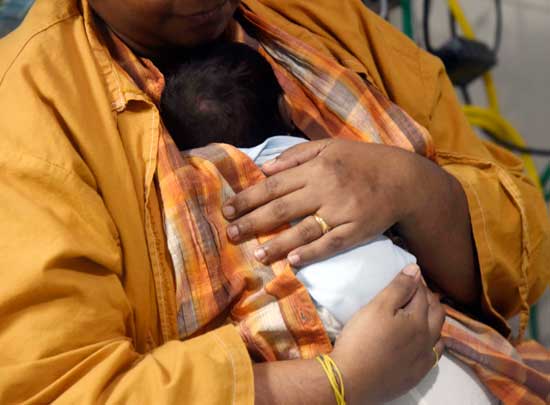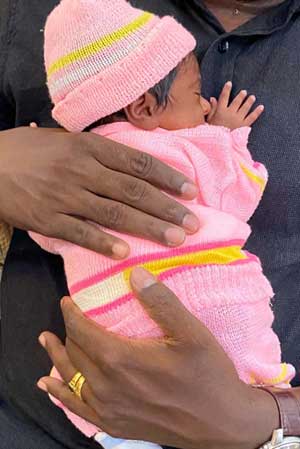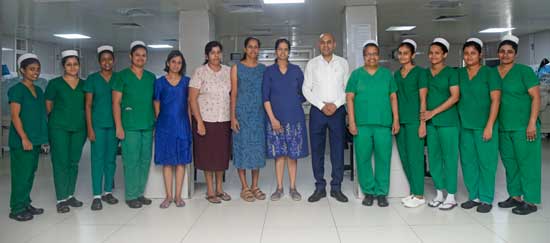A tale of two babies and a dedicated team
Whispered endearments interspersed with light fairy kisses atop a tiny head of a baby girl held close by her mother!
The common and simple portrayal of a mother and baby…….but what we see on Wednesday afternoon at the Premature Baby Unit (PBU) of the De Soysa Maternity Hospital (DMH) for Women down Kynsey Road, Colombo 8, is neither common nor simple.
Behind that portrait is a tale of early heart-wrenching agony and a state system comprising dedicated doctors, nurses and other staff who never gave up on the most vulnerable.

The twins: 'Akka' in her mother's arms and (right), the little one snug in her proud father's embrace. Pix by Akila Jayawardena
It is also a tale of a ‘first’ – not reported before in Sri Lanka. Twin-girls conceived together, one born extremely prematurely at 25 weeks when survival is rare and the other born at 32 weeks. Both doing well now.
One nurtured, protected and cared for in an incubator by DMH’s Neonatal Intensive Care Unit (NICU) team under Consultant Neonatalogist Dr. Nalin Gamaathige and the other safeguarded and monitored in the mother’s womb by the Obstetrics & Gynaecology team under Consultant Obstetrician & Gynaecologist Dr. R. Prathapan.
 Married 10 years ago, two professionals in their 30s with hectic schedules did not attempt to begin a family for three years as they were also living abroad. Back in Colombo, they tried but had four pregnancy failures and then “magically” found they were expecting twins around July last year.
Married 10 years ago, two professionals in their 30s with hectic schedules did not attempt to begin a family for three years as they were also living abroad. Back in Colombo, they tried but had four pregnancy failures and then “magically” found they were expecting twins around July last year.
The mother was fine except for a slight elevation in her blood sugar. Having attended to her in the pregnancy that did not work out just before this, Dr. Prathapan had done a ‘cervical cerclage’, a surgical procedure to position a suture (stitch) around the neck of the womb (cervix). This was due to her previous history of miscarriages and to reduce the risk of pre-term or premature birth (before 37 weeks) of the twins.
A baby is considered full-term when born between 39 weeks and 40 weeks and 6 days of gestation (the period between conception and birth). The weight of such a baby is over 2.5kg.
Trouble began end-January, this year, for the couple when the mother’s water broke at just 25 weeks.
“It was early morning,” says Dr. Prathapan, recalling how he and his “extraordinary” team had no option for the twin who had come so early out of the womb. Almost out, she was in breech position, feet first instead of the head, through the cervical cerclage. “The situation was hopeless but we had to deliver her with heavy hearts, not knowing what her survival outcome would be as it was extreme prematurity. We performed a natural delivery.”
The 25-week baby born on January 29, was only a mere 580g, slightly over half-a-kilo. Hopes were bleak. However, right there was a battalion ready to take up her cause.
“Harima chooti, athata ahu wenney nethi tharam,” says Nursing Officer-in-Charge of the NICU, Sr. H.H.I. Champika, explaining that the baby was tiny and did not even fit into the hand.
The NICU team, ensconcing the baby in a warm chamber with breathing support, rushed her to the NICU which would be her home away from her mother’s womb, to grow strong enough to go into the world.
Pointing towards a high pile of clinical notes including numerous X-rays, Dr. Gamaathige says when born so early there are huge life-threatening risks. All systems including the lungs, heart, brain and gut are not mature. The NICU team has to simulate the environment in the mother’s womb for the baby to survive.
“This requires meticulous support and monitoring,” he says, paying strong tribute to his team.
Echoes Sr. Champika: “Neonatal care protocols were strictly followed including maintenance of temperature, respiratory support and nutrition.
In the early days, it was nasogastric (NG) feeding for the milk through a narrow tube placed through the nose into the stomach and ‘parenteral’ feeding intravenously for other nutrition.
“We found it very difficult to find her tiny vessels,” says Sr. Champika.

The biggest challenge, the team faced was that the baby’s mother could not be around as she was still carrying the other twin, which the obstetrics team was hoping would remain in the womb for a while more at least.
“We had to be attuned to the baby’s every need,” says Sr. Champika. A wrinkled forehead would mean she was in pain. The care had to be seamless with no gaps as they had to make decisions on the condition of the baby through monitors and observation power.
With much emotion, she reiterates that all babies, whatever the disadvantages, should be given a chance at survival.
The saga of the second twin is picked up next by Dr. Prathapan who was “patient” and hopeful”. After the birth of the first twin, her placenta which should have also been delivered, remained intact inside the mother’s womb. This was while the cervix did not remain dilated (wide open).
He and his team had to think on their feet as there are no textbook answers in such situations. “I felt nature was supporting the second twin and us, as there were no contractions and no infection.”
A nail-biting wait followed. “We watched and waited a few hours, a day, two days, more days, a week and more” fearful that the placenta would get delivered, causing bleeding in the womb. Dr. Prathapan held back without putting that usual stitch around the cervix in premature situations.

The team: Going beyond the call of duty
With the support of the microbiology team, they caught and treated an infection with antibiotics for two weeks. “In three weeks we told the mother to go home,” says Dr. Prathapan who closely monitored her even there, getting an update on the phone every few days from her.
On another early morning, the mother came back with pain – the contractions had begun and the second twin wanted out. She was 32 weeks plus five days. Delivered on March 21, 52 days after her older twin sister, her weight was 1.8kg.
Soon there is to be a joyous reunion of the twins, when the older twin nearly 95 days in the NICU and the PBU, will be home where the younger one is already comfortably settled. It is “miraculous” for the family, as ‘Akka’ now 1.6kg is without any anomalies including neurological issues.
The father and mother are overjoyed. They had been yearning earlier for one and now they have got a “bonus” with two.
“It is all to do with the doctors and nurses who went beyond the call of duty, way, way beyond duty,” says the mother with emotion.
| The milk of human kindness | |
| Nutritional rehabilitation has to begin immediately, says Dr. Nalin Gamaathige, but how could they find breast milk for the first twin.As the mother was still carrying the second twin, no milk was forthcoming. Therefore, they sought permission from the parents of the twins to seek milk donations from other mothers with pre-term babies as young as the first twin. “All of them gave milk in the spirit of daana which Sri Lankans become a willing part of,” said Dr. Gamaathige, while Sr. H.H.I. Champika adds that a mother who had lost her premature baby due to a very low gestation age left a bottleful even on the day of her discharge as a meritorious deed. A strong plea comes from Dr. Gamaathige for a ‘milk bank’ to be set up following stringent protocols. |
Searching for an ideal partner? Find your soul mate on Hitad.lk, Sri Lanka's favourite marriage proposals page. With Hitad.lk matrimonial advertisements you have access to thousands of ads from potential suitors who are looking for someone just like you.


